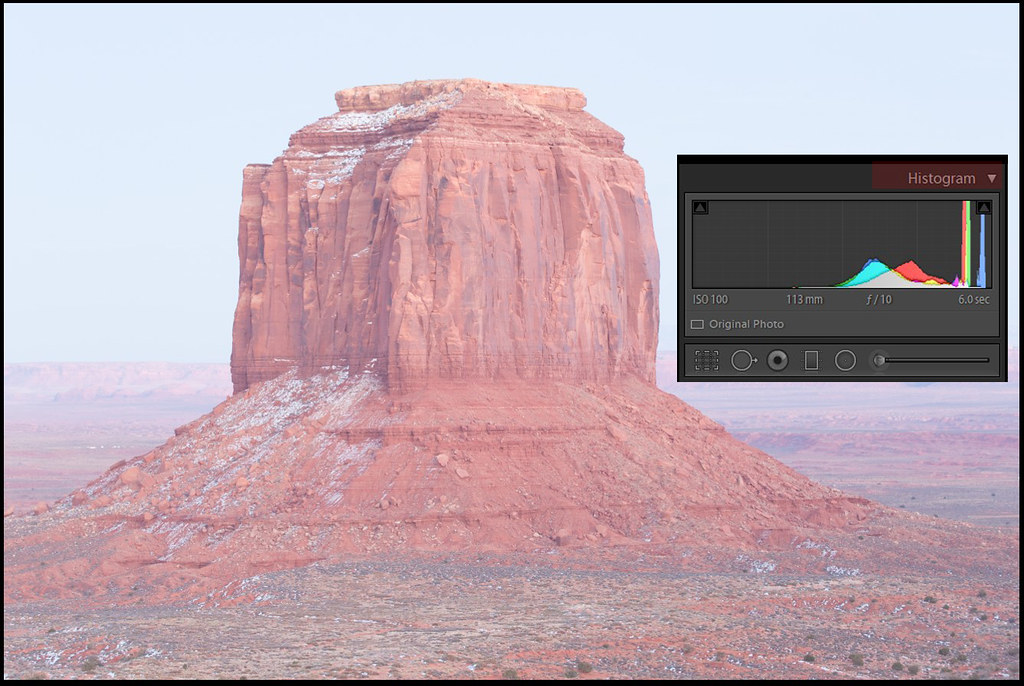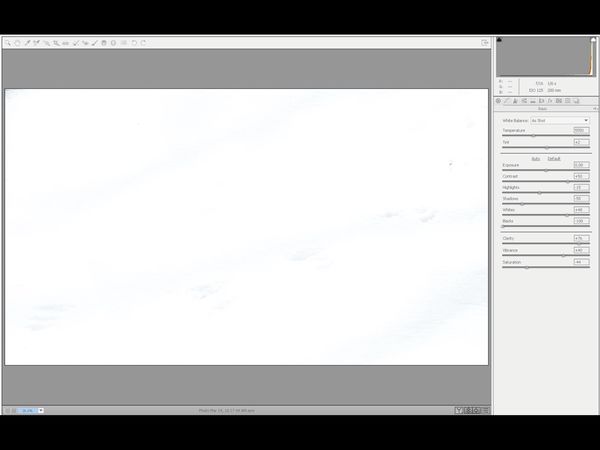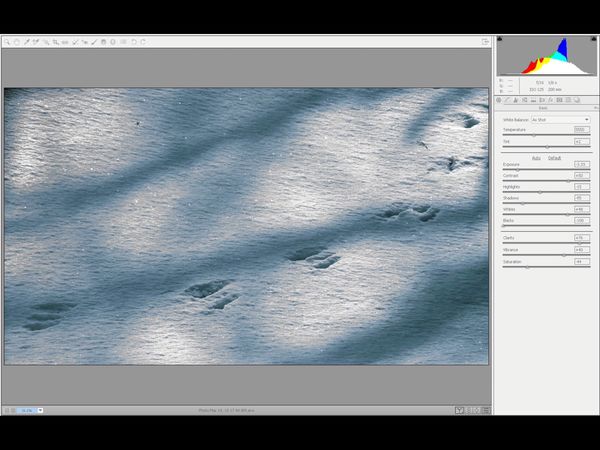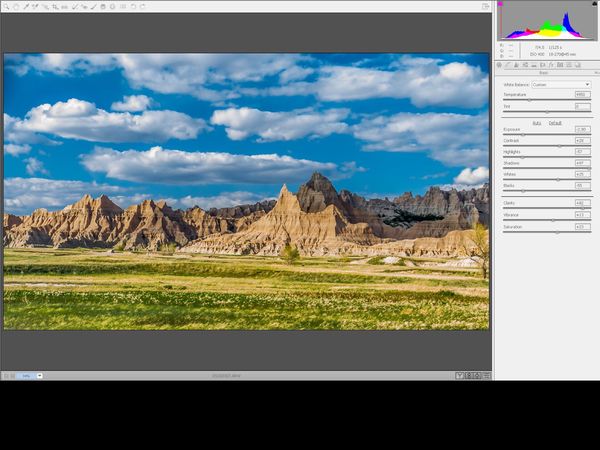ETTR in landscape photography
Dec 5, 2018 15:13:45 #
larryepage wrote:
My experience with highlight weighted metering is still pretty new. Specifically, I am still working to learn exactly what to do with exposure compensationto get absolutely the most ideal results. But my guess right now is that the question is irrelevant as you propose, especially once the ec fine tuning is complete.
The icing on the cake would be to find that highlights weighted brings you consistently close to blowing the highlights and you can determine exactly how much EC will take you to the limit.
Dec 5, 2018 15:54:47 #
rmalarz wrote:
R.G., Scotty is the perennial contrarian when it comes to most ETTR/EBTR statements made by me, or anyone else. It's a shame that a very worthwhile photo posted by Paul has been derailed by, yet, another thread presenting the benefits of ETTR/EBTR techniques. ...
It's not a matter of being contrarian. I have looked at the issue very closely from a technical and a visual perspective.
If you follow the the links in my earlier post you will see that RawDigger tells us exactly what raw values were recorded immediately before and after the blinkies were triggered in the three cameras I tested. They occur around a 14-bit raw value of 8191 +/- about 1/6 stop - consistently for all three cameras I tested. That's very close to binary '01111111111111'.
Since we know that a 14-bit raw file cannot record a value above 16383 - binary '11111111111111' - that clearly points to a one stop difference from the point that blinkies begin and where the raw file blows out.
But all of this presents only the hard facts of ETTR/EBTR - the math and science underlining the process.
Nowhere have I ever seen a demonstration of the actual visible benefits of ETTR under any conditions except for the situations I listed in my following post.
Dec 5, 2018 16:00:17 #
CHG_CANON wrote:
6 sec at f/10, ISO-100 (Canon EOS 5DIII) Processed results using LR6 and Topaz DeNoise v6
Merrick Butte

Original - purposfully overexposed, but no highlight warnings

Merrick Butte

Original - purposfully overexposed, but no highlight warnings

That's a beautiful photo and an interesting discussion. I know from experience how a photo that's been pushed too far to the right can be improved by pulling the exposure down but I get nervous about doing it intentionally. It's just a psychological hurdle that I probably need to get over and your image shows me I should try hard to overcome it and practice up on it and read up on it. I find it interesting also that there wasn't more PP work done on it than just Lr and Denoise. Thank you for posting.
Walt
Dec 5, 2018 16:06:53 #
R.G. wrote:
The icing on the cake would be to find that highlights weighted brings you consistently close to blowing the highlights and you can determine exactly how much EC will take you to the limit.
Probably a more important question is whether there is any need to actually take it to the limit and use EBTR.
If the difference is only about one stop, as RawDigger shows me, how much less noise would one stop make?
What if you already don't see any noise because you are exposing close to base ISO? Or if the scene's dynamic range is not too wide.
And how much better will the tonality and color be rendered if you add a stop of exposure and then reverse that during post processing?
These are image quality issues that are difficult to demonstrate side-by-side. Nobody cam prove with certainty that EBTR is actually worth the effort and risk.
Dec 5, 2018 19:45:57 #
Thanks for opening this Topic and presenting the fantastic sample images that perfectly display the ETTR concept. I take mostly wildlife photos on Manual with Auto-ISO so that exposure should be correct, but the majority of my shots are darker subjects against a medium to dark background (plants, water, sky), and this pushed the exposure into the left side of the histogram resulted in significant noise even when my metering seemed to be correct. I could see that the majority of the pixels of each image were in the left side of the graph but I wasn't blocking at either end of the exposure. I wanted to keep a high shutter speed (usually 1/800 to 1/2500) to freeze action and keep a wide aperture for soft bokeh. I adjusted by setting the Exposure Compensation to +1.7 to +2.0 as my default and this has been providing the extra exposure I need to significantly brighten the photos for ETTR. Sure enough, even through the ISO is higher because of the EV + setting, the noise is significantly less because much more of the exposure is in the right side of the histogram. I probably can go further on many exposures. This topic has been a confidence-builder as I experiment and practice. Thanks again.
Dec 6, 2018 09:42:50 #
When I read the comment that:
“I have never seen a camera that has more than about one stop of DR beyond the point where the blinkies begin.”...my response is that the person making the comment needs to examine and accurately test one helluva lot more than the obviously few cameras he has examined and supposedly accurately tested. Also, when referring to ERADR, an explicit statement should include include ISO at which testing was performed ( if different from base ISO) and the ERADR stated to the accuracy of stop (s) and 1/3 stops. In other words “...about one stop...” indicates a casual disregard of necessary accuracy in testing and reporting results.
Rather than extend yet another thread to focus on the “hows” and “whys” of ETTR and EBTR when this thread’s stated point was to concentrate on their use in landscape imagery, I will simply provide links to a couple of threads on ETTR and EBTR that have, during the past three years, been well-received as evidenced by in-thread comments as well as by favorable comments received via PMs.
IMO most (or all) the common questions on the and “hows” and “whys”of EBTR are covered in the threads to which these links will direct you.
https://www.uglyhedgehog.com/t-372364-1.html
(Tutorial-Welcome to raw exposure)...includes helpful basics of EBTR, including how to test your camera’s ERADR.
https://www.uglyhedgehog.com/t-433990-3.html
(The meaning of ETTR and EBTR) ...another basic intro to EBTR
Best regards,
Over and out...
Dave
“I have never seen a camera that has more than about one stop of DR beyond the point where the blinkies begin.”...my response is that the person making the comment needs to examine and accurately test one helluva lot more than the obviously few cameras he has examined and supposedly accurately tested. Also, when referring to ERADR, an explicit statement should include include ISO at which testing was performed ( if different from base ISO) and the ERADR stated to the accuracy of stop (s) and 1/3 stops. In other words “...about one stop...” indicates a casual disregard of necessary accuracy in testing and reporting results.
Rather than extend yet another thread to focus on the “hows” and “whys” of ETTR and EBTR when this thread’s stated point was to concentrate on their use in landscape imagery, I will simply provide links to a couple of threads on ETTR and EBTR that have, during the past three years, been well-received as evidenced by in-thread comments as well as by favorable comments received via PMs.
IMO most (or all) the common questions on the and “hows” and “whys”of EBTR are covered in the threads to which these links will direct you.
https://www.uglyhedgehog.com/t-372364-1.html
(Tutorial-Welcome to raw exposure)...includes helpful basics of EBTR, including how to test your camera’s ERADR.
https://www.uglyhedgehog.com/t-433990-3.html
(The meaning of ETTR and EBTR) ...another basic intro to EBTR
Best regards,
Over and out...
Dave
Dec 6, 2018 09:51:28 #
I was interested in sharing ETTR ideas earlier this year, but the draft that included this image as a demonstration example never made it all the way to UHH. I took some feedback received on the draft and completed that post this morning as: https://www.uglyhedgehog.com/t-567344-1.html
Dec 6, 2018 10:55:43 #
Uuglypher wrote:
... “...about one stop...” indicates a casual disregard of necessary accuracy in testing and reporting results. ...
Clearly you have not followed any of the links in my earlier post.
I measured the differences using RawDigger and posted the raw results. The numbers are very precise. What I meant when I said "about one stop" was that the three cameras I tested did not precisely agree but that their blinkies came up at a raw value of about 8000 +/- about one sixth of a stop. That's very close agreement between Nikon and Sony. They leave only one stop beyond the blinkies before the raw file highlights blow out.
I can't speak for Canon or other brands but anyone can test their own camera using a copy or RawDigger and the procedure I documented in those threads.
Meantime look at my latest thread, ETTR vs. ISO Invariance. I provide a comparison of ETTR with an image captured more than two stops darker and corrected in post processing. If you can look at those results with an open mind you will be hard pressed to find a visible difference.
Dec 6, 2018 11:46:07 #
When your camera’s ERADR has been accurately (and easily) determined, you will find that, when adequate care is taken to establish the ETTR exposure, avoidance of blown highlights in the subsequent EBTR capture is assured.
However, some who use EBTR are still skittish about clipped highlight detail and are compulsive about bracketing their EBTR exposures.
It is generally unnecessary, but remember; if your original ERADR testing was accomplished with reasonable care, you will be assured then that wheneven just a 1/3 greater exposure is added to your routine EBTR addition, it is guaran-damn-teed to clip some highlights. So, if you are determined to bracket your EBTR exposure, you need only bracket to the darker side...to decrease it by 1/3 stop.
Now....To get back to some examples of EBTR here are the SOOC (pre-tonal normalization in ARC) and post normalization versions of two different sorts of “scapes”.
I particularly enjoy capturing the moods and expression of snow surfaces, and am thus careful (some say fanatical...) about tonal management in the higher exposure zones. The “blown” highlights I intend, purposefully, to capture are the specular reflections of the sun from individual, appropriately angled snowflakes.
And, of course, I find it impossible to pass on the innumerable vistas offered by the South Dakota and North Dakota Badlands.
Dave
However, some who use EBTR are still skittish about clipped highlight detail and are compulsive about bracketing their EBTR exposures.
It is generally unnecessary, but remember; if your original ERADR testing was accomplished with reasonable care, you will be assured then that wheneven just a 1/3 greater exposure is added to your routine EBTR addition, it is guaran-damn-teed to clip some highlights. So, if you are determined to bracket your EBTR exposure, you need only bracket to the darker side...to decrease it by 1/3 stop.
Now....To get back to some examples of EBTR here are the SOOC (pre-tonal normalization in ARC) and post normalization versions of two different sorts of “scapes”.
I particularly enjoy capturing the moods and expression of snow surfaces, and am thus careful (some say fanatical...) about tonal management in the higher exposure zones. The “blown” highlights I intend, purposefully, to capture are the specular reflections of the sun from individual, appropriately angled snowflakes.
And, of course, I find it impossible to pass on the innumerable vistas offered by the South Dakota and North Dakota Badlands.
Dave
Dec 6, 2018 12:27:38 #
Uuglypher wrote:
When your camera’s ERADR has been accurately (and easily) determined, you will find that, when adequate care is taken to establish the ETTR exposure, avoidance of blown highlights in the subsequent EBTR capture is assured. ...
The first image (snow) is exposed almost entirely within Zone VIII. It is a low DR scene. There are no highlight warnings to indicate that the raw file highlights are blown even though there are some scattered specular highlights which are to be expected.
In the second image (sky and mountains), there are highlight warnings in the clouds and in some of the rocks. These are not specular highlights. They are areas where there will be no texture or tonality after you reduce the exposure or try to recover those highlights. The evidence is in the developed version. The areas where the warnings appeared are still pure white.
I guess you overestimated your ERADR.
Dec 6, 2018 12:41:55 #
Dec 6, 2018 13:24:01 #
Rich1939 wrote:
Gentlemen, Please!!
I agree!
Dave and I should have this conversation offline but he has me on his Ignore list.
As an alternative, he can start a new thread in the Photo Gallery like I did or in the Main Photography Discussion and move the discussion of ETTR, etc., out of the Landscape Photography forum.
Then he can post a RawDigger analysis of both of his images. It will tell everyone precisely how many pixels for each of the three colors are beyond the reach of the raw file in the two images he has posted.
Dec 6, 2018 13:35:14 #
selmslie wrote:
.........They leave only one stop beyond the blinkies before the raw file highlights blow out......
You appear to be assuming that the raw file maxes out at exactly the sensor's limits. Careful testing by many competent people has shown that in many cameras there is undeniably and significantly more than one stop of extra sensor capability beyond the jpeg-oriented limits. I think what you're ignoring is the possibility that it's not just the jpeg file's limits that fall short of the sensor's limits, the raw file's limits also fall short.
Rather than assume that the raw file and the sensor share the same limits, the only way to accurately ascertain the sensor's limits is to use the camera settings to keep lifting the exposure (which the raw file will faithfully record) until the image shows properly blown highlights. There are many people who have gone through that procedure and come up with values bigger than one stop.
BTW I think the blinkies will be triggered by the most significant bit of the raw value turning to 1, not the others all turning to 1. That way only the MSB needs to be monitored.
Dec 6, 2018 14:34:52 #
R.G. wrote:
You appear to be assuming that the raw file maxes out at exactly the sensor's limits. ....
Absolutely not! That would only be the case when shooting at base ISO or lower.
At ISO 200 the gain is doubled but the raw file will still max out at 16383 in any channel but only half of the sensor's capacity is used. At ISO 400 the gain is doubled again but only 1/4th of the sensor's capacity is used.
There are two exceptions to this:
1. When you lower the ISO below base, the sensor still uses the full physical capacity of the sensor but the gain is reduced. Something that might have recorded as 8000 at base ISO will be record as 4000 at ISO 50. This works for a narrow DR but you can easily imagine what it can lead to if the scene's DR is too wide. Increasing the exposure can easily go beyond the physical capacity of the sensor.
2. There are some anomalies in the actual maximum values that RawDigger finds in the raw file. I have seen cases where the red or blue channel actually reach 16383 but others where the green channels stop short at a lower value like 15539. But the lower figure represents only about 0.08 stops which is insignificant.
You can look at this in more detail at https://www.uglyhedgehog.com/t-567359-1.html#9656528 It shows a precise indication of where the raw file values reach their maximum.
Dec 6, 2018 14:39:08 #
R.G. wrote:
... BTW I think the blinkies will be triggered by the most significant bit of the raw value turning to 1, not the others all turning to 1. That way only the MSB needs to be monitored.
Exactly right! The JPEG blinkies appear to be triggered by the most significant bit.
But the difference is very small - 8191='01111111111111' and 8192='10000000000000'
If you want to reply, then register here. Registration is free and your account is created instantly, so you can post right away.









